This article needs additional citations for verification .(May 2015) |
Spent mushroom compost is the residual compost waste generated by the mushroom production industry.
This article needs additional citations for verification .(May 2015) |
Spent mushroom compost is the residual compost waste generated by the mushroom production industry.
It is readily available (bagged, at nursery suppliers), and its formulation generally consists of a combination of wheat straw, dried blood, horse manure and ground chalk, composted together. It is an excellent source of humus, although much of its nitrogen content will have been used up by the composting and growing mushrooms. It remains, however, a good source of general nutrients (0.7% N, 0.3% P, 0.3% K plus a full range of trace elements), as well as a useful soil conditioner. However, due to its chalk content, it may be alkaline, and should not be used on acid-loving plants, nor should it be applied too frequently, as it will overly raise the soil's pH levels. [1]
Mushroom compost may also contain pesticide residues, particularly organochlorides used against the fungus gnat. If the compost pile was stored outside, it may contain grubs or other insects attracted to decaying matter. Chemicals may also have been used to treat the straw, and also to sterilize the compost. Therefore, the organic gardener must be careful regarding the sourcing of mushroom compost; if in doubt, samples can be analyzed for contamination – in the UK, the Department for Environment, Food and Rural Affairs is able to advise regarding this issue.
Commercially available 'spent' mushroom compost is not always truly spent. It is sold by mushroom farms when it is no longer producing commercially viable yields of mushrooms. It can be used to grow further smaller crops of mushrooms before final use on the garden. [2]

Compost is a mixture of ingredients used to fertilize and improve the soil. It is commonly prepared by decomposing plant and food waste and recycling organic materials. The resulting mixture is rich in plant nutrients and beneficial organisms, such as worms and fungal mycelium. Compost improves soil fertility in gardens, landscaping, horticulture, urban agriculture, and organic farming. The benefits of compost include providing nutrients to crops as fertilizer, acting as a soil conditioner, increasing the humus or humic acid contents of the soil, and introducing beneficial colonies of microbes that help to suppress pathogens in the soil. It also reduces expenses on commercial chemical fertilizers for recreational gardeners and commercial farmers alike. Compost can also be used for land and stream reclamation, wetland construction, and landfill cover.

Raised-bed gardening is a form of gardening in which the soil is enclosed in three-to-four-foot-wide (1.0–1.2 m) containment units ("beds"), which are usually made of wood, rock, or concrete and which can be of any length or shape. The soil is raised above the surrounding soil and may be enriched with compost.

Straw is an agricultural byproduct consisting of the dry stalks of cereal plants after the grain and chaff have been removed. It makes up about half of the yield of cereal crops such as barley, oats, rice, rye and wheat. It has a number of different uses, including fuel, livestock bedding and fodder, thatching and basket making.
No-dig gardening is a non-cultivation method used by some organic gardeners. The origins of no-dig gardening are unclear, and may be based on pre-industrial or nineteenth-century farming techniques. Masanobu Fukuoka started his pioneering research work in this domain in 1938, and began publishing in the 1970s his Fukuokan philosophy of "do-nothing farming" or natural farming, which is now acknowledged by some as the tap root of the permaculture movement. Two pioneers of the method in the twentieth century included F. C. King, Head Gardener at Levens Hall, South Westmorland, in the Lake District of England, who wrote the book "Is Digging Necessary?" in 1946 and a gardener from Middlecliffe in the UK, A. Guest, who in 1948 published the book "Gardening Without Digging". The work of these gardeners was supported by the Good Gardeners Association in the UK. No-dig gardening was also promoted by Australian Esther Deans in the 1970s, and American gardener Ruth Stout advocated a "permanent" garden mulching technique in Gardening Without Work and no-dig methods in the 1950s and 1960s.

Vermicompost (vermi-compost) is the product of the decomposition process using various species of worms, usually red wigglers, white worms, and other earthworms, to create a mixture of decomposing vegetable or food waste, bedding materials, and vermicast. This process is called vermicomposting, while the rearing of worms for this purpose is called vermiculture.
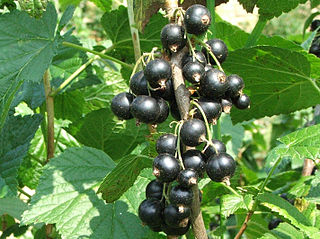
The blackcurrant, also known as black currant or cassis, is a deciduous shrub in the family Grossulariaceae grown for its edible berries. It is native to temperate parts of central and northern Europe and northern Asia, where it prefers damp fertile soils. It is widely cultivated both commercially and domestically.

The parsnip is a root vegetable closely related to carrot and parsley, all belonging to the flowering plant family Apiaceae. It is a biennial plant usually grown as an annual. Its long taproot has cream-colored skin and flesh, and, left in the ground to mature, it becomes sweeter in flavor after winter frosts. In its first growing season, the plant has a rosette of pinnate, mid-green leaves. If unharvested, in its second growing season it produces a flowering stem topped by an umbel of small yellow flowers, later producing pale brown, flat, winged seeds. By this time, the stem has become woody and the tap root inedible.
Vegan organicagriculture is the organic production of food and other crops with minimal animal inputs. Vegan organic agriculture is the organic form of animal-free agriculture.

A mulch is a layer of material applied to the surface of soil. Reasons for applying mulch include conservation of soil moisture, improving fertility and health of the soil, reducing weed growth and enhancing the visual appeal of the area.
Biointensive agriculture is an organic agricultural system that focuses on achieving maximum yields from a minimum area of land, while simultaneously increasing biodiversity and sustaining the fertility of the soil. The goal of the method is long term sustainability on a closed system basis. It is particularly effective for backyard gardeners and smallholder farmers in developing countries, and also has been used successfully on small-scale commercial farms.

Organic horticulture is the science and art of growing fruits, vegetables, flowers, or ornamental plants by following the essential principles of organic agriculture in soil building and conservation, pest management, and heirloom variety preservation.
A soil conditioner is a product which is added to soil to improve the soil’s physical qualities, usually its fertility and sometimes its mechanics. In general usage, the term "soil conditioner" is often thought of as a subset of the category soil amendments, which more often is understood to include a wide range of fertilizers and non-organic materials.
Fungiculture is the cultivation of mushrooms and other fungi. Cultivating fungi can yield food, medicine, construction materials and other products. A mushroom farm is in the business of growing fungi.
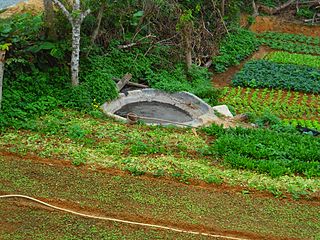
Organic fertilizers are fertilizers that are naturally produced and contain carbon (C). Fertilizers are materials that can be added to soil or plants, in order to provide nutrients and sustain growth. Typical organic fertilizers include mineral sources, all animal waste including meat processing, manure, slurry, and guano, plant based fertilizers, such as compost, and biosolids. There are also other abiotic non-chemical, fertilizer methods that meet the Principles of Organic Agriculture, which determines whether a fertilizer can be used for commercial organic agriculture.
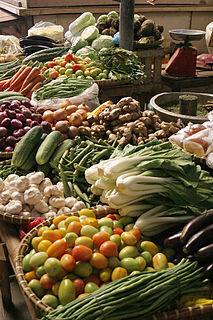
Vegetables are parts of plants that are consumed by humans or other animals as food. The original meaning is still commonly used and is applied to plants collectively to refer to all edible plant matter, including the flowers, fruits, stems, leaves, roots, and seeds. An alternate definition of the term is applied somewhat arbitrarily, often by culinary and cultural tradition. It may exclude foods derived from some plants that are fruits, flowers, nuts, and cereal grains, but include savoury fruits such as tomatoes and courgettes, flowers such as broccoli, and seeds such as pulses.
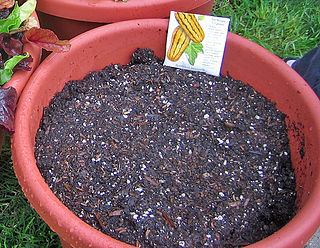
Potting soil, also known as potting mix or miracle soil, is a medium in which to grow plants, herbs and vegetables in a pot or other durable container. The first recorded use of the term is from an 1861 issue of the American Agriculturist.

Manure is organic matter that is used as organic fertilizer in agriculture. Most manure consists of animal feces; other sources include compost and green manure. Manures contribute to the fertility of soil by adding organic matter and nutrients, such as nitrogen, that are utilised by bacteria, fungi and other organisms in the soil. Higher organisms then feed on the fungi and bacteria in a chain of life that comprises the soil food web.
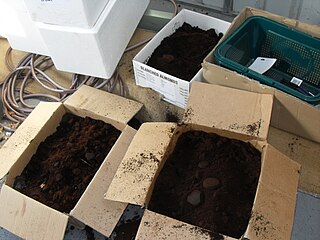
Used coffee grounds is the result of brewing coffee, and are the final product after preparation of coffee. Used coffee grounds are generally regarded as waste, and is usually thrown away or composted. In the late 19th century, used coffee grounds were used to adulterate pure coffee.

Hügelkultur is a horticultural technique where a mound constructed from decaying wood debris and other compostable biomass plant materials is later planted as a raised bed. Adopted by permaculture advocates, it is suggested the technique helps to improve soil fertility, water retention, and soil warming, thus benefiting plants grown on or near such mounds.
Verticillium dry bubble, recently named Lecanicillium fungicola, is a mycoparasite that attacks white button mushrooms, among other hosts, during its generative period. L. fungicola infects the casing layer on the cap structure of several edible mushrooms. This fungal pathogen does not typically infect wild mushrooms, but more commonly cultivated mushrooms are infected such as A. bisporus, which are typically grown in large quantities. Severity of disease depends on several factors, including timing of infection and environmental conditions. Dry bubble follows the typical verticillium life cycle, although insect vectors play a large role in the spread of this disease. Control for L. fungicola is limited, and strict measures must be taken to prevent the spread of infection. L. fungicola is a devastating pathogen in the mushroom industry and causes significant losses in the commercial production of its main host A. bisporus. Annual costs for mushroom growers are estimated at 2–4% of total revenue.